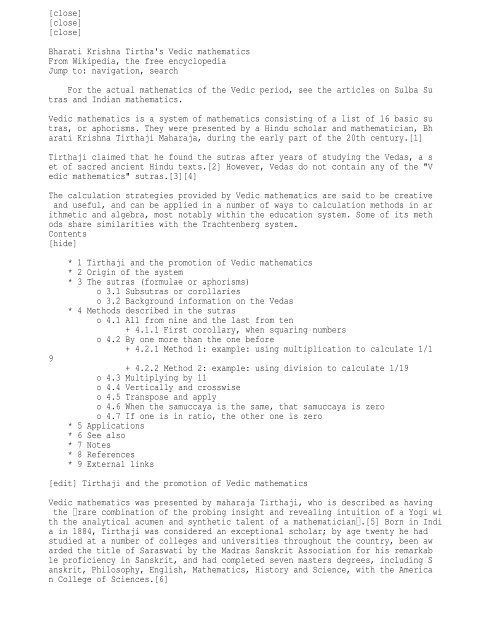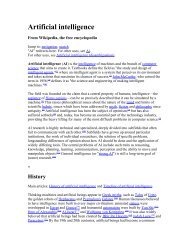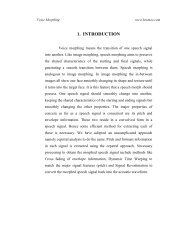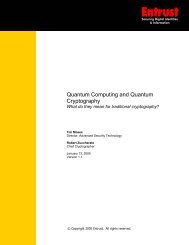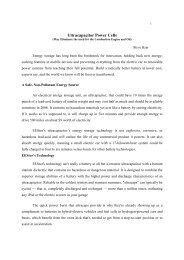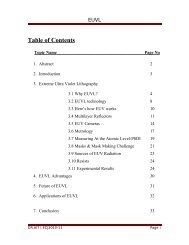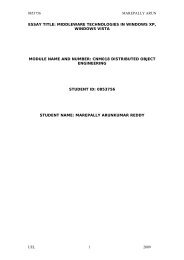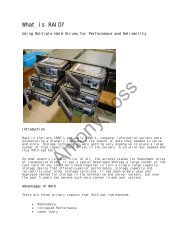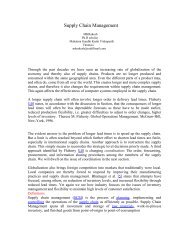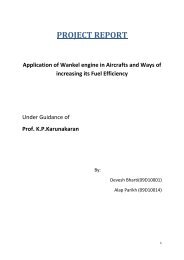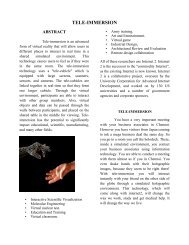Vedic Math.pdf - 123SeminarsOnly
Vedic Math.pdf - 123SeminarsOnly
Vedic Math.pdf - 123SeminarsOnly
Create successful ePaper yourself
Turn your PDF publications into a flip-book with our unique Google optimized e-Paper software.
[close]<br />
[close]<br />
[close]<br />
Bharati Krishna Tirtha's <strong>Vedic</strong> mathematics<br />
From Wikipedia, the free encyclopedia<br />
Jump to: navigation, search<br />
For the actual mathematics of the <strong>Vedic</strong> period, see the articles on Sulba Su<br />
tras and Indian mathematics.<br />
<strong>Vedic</strong> mathematics is a system of mathematics consisting of a list of 16 basic su<br />
tras, or aphorisms. They were presented by a Hindu scholar and mathematician, Bh<br />
arati Krishna Tirthaji Maharaja, during the early part of the 20th century.[1]<br />
Tirthaji claimed that he found the sutras after years of studying the Vedas, a s<br />
et of sacred ancient Hindu texts.[2] However, Vedas do not contain any of the "V<br />
edic mathematics" sutras.[3][4]<br />
The calculation strategies provided by <strong>Vedic</strong> mathematics are said to be creative<br />
and useful, and can be applied in a number of ways to calculation methods in ar<br />
ithmetic and algebra, most notably within the education system. Some of its meth<br />
ods share similarities with the Trachtenberg system.<br />
Contents<br />
[hide]<br />
9<br />
* 1 Tirthaji and the promotion of <strong>Vedic</strong> mathematics<br />
* 2 Origin of the system<br />
* 3 The sutras (formulae or aphorisms)<br />
o 3.1 Subsutras or corollaries<br />
o 3.2 Background information on the Vedas<br />
* 4 Methods described in the sutras<br />
o 4.1 All from nine and the last from ten<br />
+ 4.1.1 First corollary, when squaring numbers<br />
o 4.2 By one more than the one before<br />
+ 4.2.1 Method 1: example: using multiplication to calculate 1/1<br />
+ 4.2.2 Method 2: example: using division to calculate 1/19<br />
o 4.3 Multiplying by 11<br />
o 4.4 Vertically and crosswise<br />
o 4.5 Transpose and apply<br />
o 4.6 When the samuccaya is the same, that samuccaya is zero<br />
o 4.7 If one is in ratio, the other one is zero<br />
* 5 Applications<br />
* 6 See also<br />
* 7 Notes<br />
* 8 References<br />
* 9 External links<br />
[edit] Tirthaji and the promotion of <strong>Vedic</strong> mathematics<br />
<strong>Vedic</strong> mathematics was presented by maharaja Tirthaji, who is described as having<br />
the rare combination of the probing insight and revealing intuition of a Yogi wi<br />
th the analytical acumen and synthetic talent of a mathematician .[5] Born in Indi<br />
a in 1884, Tirthaji was considered an exceptional scholar; by age twenty he had<br />
studied at a number of colleges and universities throughout the country, been aw<br />
arded the title of Saraswati by the Madras Sanskrit Association for his remarkab<br />
le proficiency in Sanskrit, and had completed seven masters degrees, including S<br />
anskrit, Philosophy, English, <strong>Math</strong>ematics, History and Science, with the America<br />
n College of Sciences.[6]
Around 1911, Tirthaji resolved to study several sections of the Atharva-veda tha<br />
t he said had been dismissed by Orientalists, Indologists and antiquarian schola<br />
rs as nonsensical.[7] He was part of a shrinking group of Indian scholars who be<br />
lieved that the Vedas represented an inexhaustible mine of profound wisdom both sp<br />
iritual and secular (Pratyagatmananda, 1965). Tirthaji claimed that there were s<br />
ections of the Atharva-veda labeled ganita sutras or mathematical formulae that myst<br />
eriously made no obvious reference to mathematics.[8] Tirthaji explains that he<br />
was determined to understand the ganita sutra references, and began studying ancie<br />
nt lexicons and lexicography in more detail.[9] With this resolve, Tirthaji went<br />
to Sringeri, Karnataka, where he began years of solitary study and meditation.[<br />
10]<br />
Eight years later, Tirthaji emerged claiming to have deciphered 16 fundamental m<br />
athematical sutras in the Vedas, which today have become the foundation of <strong>Vedic</strong><br />
mathematics.[11] According to Tirthaji, the sutras cover every branch of mathem<br />
atics, from arithmetic to spherical conics, and that there is no mathematics beyo<br />
nd their jurisdiction .[12]<br />
After discovering the sutras, Tirthaji traveled around India presenting <strong>Vedic</strong> ma<br />
thematics, and even lectured in the United States and England in 1958 (Trivedi,<br />
1965). In addition to lecturing, Tirthaji also wrote sixteen volumes, one for ea<br />
ch basic sutra, explaining their applications.[13] Before they were published, t<br />
he manuscripts were lost irretrievably. The book "<strong>Vedic</strong> <strong>Math</strong>ematics" carries a s<br />
mall biographical sketch of the Late swamiji by one of his disciples. In this in<br />
troduction it is stated that ".. the Swamiji used to say that he had written six<br />
teen volumes on these sutras, one for each sutra and that the manuscripts were d<br />
eposited at the house of one of his disciples...". The introduction further stat<br />
es that Swamiji was unperturbed by the loss of manuscripts and indicated that he<br />
would rewrite the sixteen volumes.[clarification needed][14] Before falling ill<br />
and dying in 1960, Tirthaji was able to rewrite only the first of the sixteen v<br />
olumes he had composed.[15] This text simply titled <strong>Vedic</strong> <strong>Math</strong>ematics, and publi<br />
shed in 1965 has become the basis for all study in the area.[16]<br />
[edit] Origin of the system<br />
There has been much controversy among Indian scholars about Tirthaji s claims that<br />
the mathematics is <strong>Vedic</strong> and that it encompasses all aspects of mathematics (Ka<br />
nsara, 2000).<br />
First, Tirthaji s description of the mathematics as <strong>Vedic</strong> is most commonly critici<br />
sed on the basis that, thus far, none of the sutras can be found in any extant V<br />
edic literature (Williams, 2000). When challenged by Prof K.S. Shukla to point o<br />
ut the sutras in question in the Parishishta of the Atharvaveda, Shukla reported<br />
that the swamiji said that the sixteen sutras were not in the standard editions<br />
of the Parishishta, and that they occurred in his own Parishishta and not any o<br />
ther.[17][18] Considering the lack of references to the sutras, coupled with the<br />
fact that the language style does not seem <strong>Vedic</strong>, some propose that the sutras<br />
were simply composed by Tirthaji himself<br />
Critics have questioned whether this subject deserves the name <strong>Vedic</strong> or indeed m<br />
athematics. They point to the lack of evidence of any sutras from the <strong>Vedic</strong> peri<br />
od consistent with the system, the inconsistency between the topics addressed by<br />
the system (such as decimal fractions) and the known mathematics of early India<br />
, the substantial extrapolations from a few words of a sutra to complex arithmet<br />
ic strategies, and the restriction of applications to convenient, special cases.<br />
They further say that such arithmetic as is sped up by application of the sutra<br />
s can be performed on a computer or calculator anyway, making their knowledge ra<br />
ther irrelevant in the modern world.[19]<br />
They are also worried that it deflects attention from genuine achievements of an
cient and modern Indian mathematics and mathematicians, and that its promotion b<br />
y Hindu nationalists may damage mathematics education in India.[20]<br />
In response to criticisms that the sutras cannot be located within the texts, se<br />
veral people have explained how textual references should not be the basis for e<br />
valuating the <strong>Vedic</strong>ity of the mathematics (Agrawala, 1992). Some propose that Ve<br />
dic mathematics is different than other scientific work because it is not pragma<br />
tically worked out, but is based on a direct revelation, or an intuitional visual<br />
isation of fundamental mathematical truths (Agrawala, 1992; Pratyagatmananda, 196<br />
5). Tirthaji has been described as having the same reverential approach towards th<br />
e Vedas as the ancient rishis that formed them. Thus, it seems as though some be<br />
lieve that Tirthaji may not have found the sutras within the Vedas, but that he<br />
received them spiritually as the rishis did, which should validate them as <strong>Vedic</strong><br />
. The controversy about the <strong>Vedic</strong>ity of the mathematics is further confused by t<br />
he double meaning of veda. Since veda can be translated to mean knowledge , it is a<br />
lso possible that <strong>Vedic</strong> mathematics simply refers to the fact that the sutras ar<br />
e supposed to present all knowledge of mathematics. Tirthaji s definition of veda<br />
does not clearly clarify whether he uses it to represent all knowledge or the Vedi<br />
c texts; rather, it seems that he uses it to refer to both.<br />
[edit] The sutras (formulae or aphorisms)<br />
<strong>Vedic</strong> mathematics is based on sixteen sutras which serve as somewhat cryptic ins<br />
tructions for dealing with different mathematical problems. Below is a list of t<br />
he sutras, translated from Sanskrit into English:<br />
* "By one more than the previous one" [21]<br />
* "All from 9 and the last from 10"[22]<br />
* "Vertically and crosswise (multiplications)"[23]<br />
* "Transpose and apply"[24]<br />
* "Transpose and adjust (the coefficient)"[25]<br />
* "If the Samuccaya is the same (on both sides of the equation, then) that S<br />
amuccaya is (equal to) zero"[26][27]<br />
* By the Paravartya rule [28][29]<br />
* "If one is in ratio, the other one is zero." [30]<br />
* "By addition and by subtraction."[31]<br />
* By the completion or non-completion (of the square, the cube, the fourth p<br />
ower, etc.)[32][33]<br />
* Differential calculus [34][35]<br />
* By the deficiency<br />
* Specific and general<br />
* The remainders by the last digit<br />
* "The ultimate (binomial) and twice the penultimate (binomial) (equals zero<br />
),"[36]<br />
* "Only the last terms,"[37][38][39][40]<br />
* By one less than the one before<br />
* The product of the sum<br />
* All the multipliers<br />
[edit] Subsutras or corollaries<br />
* "Proportionately"[41]<br />
* The remainder remains constant<br />
* "The first by the first and the last by the last" [42]<br />
* For 7 the multiplicand is 143<br />
* By osculation<br />
* Lessen by the deficiency<br />
* "Whatever the extent of its deficiency, lessen it still further to that ve<br />
ry extent; and also set up the square (of the deficiency)".[43]<br />
* "By one more than the previous one"[44]<br />
* "Last totaling ten"[45][46]
* The sum of the products<br />
* "By (alternative) elimination and retention (of the highest and lowest pow<br />
ers)"[47]<br />
* By mere observation,[48][49]<br />
* The product of the sum is the sum of the products<br />
* On the flag<br />
Editor's list of 16 Sutras and 13 Sub-sutras or corollaries from the Vedas[50]<br />
To check the factorization of polynomial expressions: "The product of the sum of<br />
the coefficients (SC) in the factors is equal to the sum of the coefficients in<br />
the product." The SC of the product (the expression) = Product of the SC (in th<br />
e factors). Additionally, this sub-sutra helps to fill in the gaps when some fac<br />
tors are known.[51]<br />
[edit] Background information on the Vedas<br />
The word veda has two basic meanings. The first, a literal translation of the Sans<br />
krit word, is knowledge (Veda). The second, and most common meaning of the word, r<br />
efers to the sacred ancient literature of Hinduism, the Vedas, a collection of h<br />
ymns, poetry and Hindu ceremonial formulae (Veda). Believed to be one of the old<br />
est human written records, the Vedas date back over 4000 years (Gaskell, 2000).<br />
Traditionally, they were passed down orally and adapted from generation to gener<br />
ation by sacred sages called rishis, before eventually emerging written in <strong>Vedic</strong><br />
, an ancient form of Sanskrit.<br />
The Vedas are divided into four main sections: the Rig-veda, Sama-veda, Yajur-ve<br />
da and the Atharva-veda, known collectively as the Samhitas (Veda). The first th<br />
ree, the Rig-veda, Sama-veda, and Yajur-veda are basically ritual handbooks that<br />
were used by priests during the <strong>Vedic</strong> period (1500 500 BCE) (Veda). <strong>Vedic</strong> mathema<br />
tics is apparently part of the fourth Veda, Atharva-veda, which is distinct from<br />
the others in several ways. First, unlike the religious focus of the other Veda<br />
s, the Atharva-veda contains hymns, spells and magical incantations for personal<br />
and domestic use (Veda). Also, the Atharva-veda, which was written later than t<br />
he other Vedas, was not always considered authoritative, but only became so afte<br />
r being accepted by the Brahmans, the highest order of Hindu priests (Veda). Col<br />
lectively, the Vedas include information about a huge range of subjects, spannin<br />
g religion, medicine, architecture, astronomy, etc. (Gaskell, 2000).<br />
Although there is controversy about whether the Vedas themselves actually includ<br />
e references to mathematics, the roots of sophisticated mathematics have actuall<br />
y been traced back to the <strong>Vedic</strong> era. Ancient Indian <strong>Vedic</strong> civilizations are know<br />
n for being skilled in geometry, algebra and computational mathematics complex e<br />
nough to incorporate things like irrational numbers (Dutta, 2002). Furthermore,<br />
all ancient Indian mathematics literature is composed completely in verse; there<br />
was a tradition of composing terse sutras, like those of <strong>Vedic</strong> mathematics, to<br />
ensure that information would be preserved even if written records were damaged<br />
or lost (Dutta, 2002).<br />
[edit] Methods described in the sutras<br />
It is not difficult to understand and apply the <strong>Vedic</strong> mathematical strategies, a<br />
s long as one does not rely on the sutras alone for mathematical insight. Those<br />
studying <strong>Vedic</strong> mathematics tend to strongly rely on the examples and explanation<br />
s Tirthaji provides in his book.<br />
[edit] All from nine and the last from ten<br />
When subtracting from a large power of ten with many columns of zeros, it is not<br />
necessary to write the notation for "borrowing" from the column on the left. On<br />
e can instead subtract the last (rightmost) digit from 10 and each other digit f<br />
rom 9. For example, when one is subtracting ten thousand minus 4,679, the leftmo<br />
st three digits of 4,679 4, 6 and 7--are subtracted from 9, and the rightmost nonz
ero digit that is, 9--is subtracted from 10, yielding the solution: 5,321. This me<br />
thod is also used when finding the deficit from the next larger power of ten whe<br />
n setting up a multiplication problem using the "cross-subtraction" method.[52]<br />
[edit] First corollary, when squaring numbers<br />
"Whatever the extent of its deficiency, lessen it still further to that very ext<br />
ent; and also set up the square (of that deficiency)"[53]<br />
For instance, in computing the square of 9 we go through the following steps:<br />
1. The nearest power of 10 to 9 is 10. Therefore, let us take 10 as our base.<br />
2. Since 9 is 1 less than 10, decrease it by the deficiency (9 - 1 = 8). This<br />
is the leftmost digit of our answer.<br />
3. On the right hand side put the square of the deficiency, which is 1². Hence,<br />
the square of nine is 81.<br />
Similarly, 8² = 64, 7² = 49, 6²=36.<br />
For numbers above 10, instead of looking at the deficit we look at the surplus.<br />
For example:<br />
11^2 = (11+1)\cdot 10+1^2 = 121.\,<br />
12^2 = (12+2)\cdot 10+2^2 = 144.\,<br />
14^2 = (14+4)\cdot 10+4^2 = 18\cdot10+16 = 196.\,<br />
25^2 = [(25+5)\cdot 2]\cdot 10+5^2 = 625.\,<br />
35^2 = [(35+5)\cdot 3]\cdot 10+5^2 = 40\cdot3\cdot10+25 = 1225.\,<br />
and so on.<br />
This method of squaring is based on the fact that a2 = (a + b)(a - b) + b2[54] w<br />
here a is the number whose square is to be found and b is the deficit (or surplu<br />
s) from nearest product of 10.<br />
[edit] By one more than the one before<br />
"Ekadhikena Purve?a" is the Sanskrit term for "[by] One more than the previous o<br />
ne". It provides a simple way of calculating values like 1/x9 (e.g.: 1/19, 1/29,<br />
etc.). The sutra can be used for multiplying as well as dividing algorithms.<br />
For example, to calculate 1/19, x = 1 . For the multiplication algorithm (workin<br />
g from right to left), the method is to start by denoting the dividend, 1, as th<br />
e first (rightmost) digit of the result. Then that digit is multiplied by 2 (i.e<br />
.: x + 1 ), and noted to that next digit to its left. If the result of this mult<br />
iplication was greater than 10, (value 10) is noted, and the "1" is noted as a c<br />
arry which will be added to the next digit directly after multiplying.<br />
The preposition "by" means the operations this formula concerns are either multi<br />
plication or division. [In case of addition/subtraction preposition "to" or "fro<br />
m" is used.] Thus this formula is used for either multiplication or division. It<br />
turns out that it is applicable in both operations.<br />
Note: This sutra can also be applied to multiplication of numbers with the same<br />
first digit and the sum of their last unit digits is 10.<br />
An interesting sub-application of this formula is in computing squares of number<br />
s ending in five. Examples:<br />
35×35 = ((3×3)+3),25 = 12,25 and 125×125 = ((12×12)+12),25 = 156,25<br />
or by the sutra, multiply "by one more than the previous one."<br />
35×35 = ((3×4),25 = 12,25 and 125×125 = ((12×13),25 = 156,25
The latter portion is multiplied by itself (5 by 5) and the previous portion is<br />
square of first digit or first two digit (3×3) or (12×12) and adding the same digit<br />
in that figure (3or12) resulting in the answer 1225.<br />
(Proof) This is a simple application of (a + b)2 = a2 + 2ab + b2 when a = 10c an<br />
d b = 5, i.e.<br />
(10c+5)^2=100c^2+100c+25=100c(c+1)+25.\,<br />
It can also be applied in multiplications when the last digit is not 5 but the s<br />
um of the last digits is the base (10) and the previous parts are the same. Exam<br />
ples:<br />
37 × 33 = (3 × 4),7 × 3 = 12,21<br />
29 × 21 = (2 × 3),9 × 1 = 6,09 ?<br />
This uses (a + b)(a - b) = a2 - b2 twice combined with the previous result to pr<br />
oduce:<br />
(10c + 5 + d)(10c + 5 - d) = (10c + 5)2 - d2 = 100c(c + 1) + 25 - d2 = 100c(<br />
c + 1) + (5 + d)(5 - d).<br />
We illustrate this sutra by its application to conversion of fractions into thei<br />
r equivalent decimal form. Consider fraction 1/19. Using this formula, this can<br />
be converted into a decimal form in a single step. This can be done by applying<br />
the formula for either a multiplication or division operation, thus yielding two<br />
methods.<br />
[edit] Method 1: example: using multiplication to calculate 1/19<br />
For 1/19, since 19 is not divisible by 2 or 5, the fractional result is a purely<br />
circulating decimal. (If the denominator contains only factors 2 and 5, the res<br />
ult is a purely non-circulating decimal, else it is a mixture of the two: a shor<br />
t non-circulating sequence of digits, followed by an endless repetition.) Each f<br />
actor of 2 or 5 or 10 in the denominator gives one fixed decimal digit.<br />
So we start with the last digit of the result, being the dividend:<br />
1<br />
Multiply this by "one more", that is, 2 (this is the "key" digit from 'Ekadhiken<br />
a')<br />
21<br />
Multiplying 2 by 2, followed by multiplying 4 by 2<br />
421 ? 8421<br />
Now, multiplying 8 by 2, sixteen<br />
68421<br />
1 ? carry<br />
multiplying 6 by 2 is 12 plus 1 carry gives 13<br />
368421<br />
1 ? carry<br />
Continuing
7368421 ? 47368421 ? 947368421<br />
1<br />
Now we have 9 digits of the answer. There are a total of 18 digits (= denominato<br />
r - 1) in the answer computed by complementing the lower half (with its compleme<br />
nt from nine):<br />
052631578<br />
947368421<br />
Thus the result is 1/19 = 0.052631578,947368421 repeating.<br />
1<br />
21<br />
421<br />
8421<br />
68421 (carry 1) we got 16, so we keep 6 and carry 1<br />
368421 (carry 1) we get 6*2 + carry 1 = 13, so we keep 3 and carry one<br />
do this to eighteen digits (19 1. If you picked up 1/29,<br />
you'll have to do it till 28 digits). You'll get the following<br />
1/19 = 052631578947368421<br />
10100111101011000<br />
Run this on your favorite calculator and check the result!<br />
[edit] Method 2: example: using division to calculate 1/19<br />
The earlier process can also be done using division instead of multiplication. W<br />
e start again with 1 (dividend of "1/x9"), dividing by 2 (" x + 1 "). We divide<br />
1 by 2, answer is 0 with remainder 1<br />
result .0<br />
Next 10 divided by 2 is five<br />
.05<br />
Next 5 divided by 2 is 2 with remainder 1<br />
.052<br />
next 12 (remainder,2) divided by 2 is 6<br />
.0526<br />
and so on.<br />
Other fractions can sometimes be converted into the format of "d/x9"; as another<br />
example, consider 1/7, this is the same as 7/49 which has 9 as the last digit o<br />
f the denominator. The previous digit is 4, by one more is 5. So we multiply (or<br />
divide) by 5, that is:<br />
7 ? 57 ? 857 ? 2857 ? 42857 ? 142857 ? .142,857 (stop after 7 - 1 digits)<br />
3 2 4 1 2<br />
[edit] Multiplying by 11<br />
11×35= 385
(1) The five in the ones place of the answer is taken from the five in 35.<br />
(2) The eight in the answer is the sum of 35 (3+5=8).<br />
(3) The three in the hundreds place of the answer is taken from the three in<br />
35.<br />
However, if in step #2 the sum is greater than 9, the sum's left digit is added<br />
the first digit of the number multiplied by 11. For example:<br />
11×59= 649<br />
(1) The nine in the ones place of the answer is taken from the nine in 59.<br />
(2) The four in the answer is the right digit in the sum of 59 (5+9=14)<br />
(3) The six in the hundreds place of the answer is taken from the sum of the<br />
five in 5'9 and the digit in the tens place from the sum of 59 (5+9=14) --> (5+<br />
1=6)<br />
The steps for multiplying a three-digit number by 11 are as follows:<br />
11×768= 8448<br />
(1) The 8 in the ones place of the answer is taken from the eight in 768.<br />
(2) The 4 in the tens place of the answer is taken from the sum of 8, in the<br />
ones place of 768, and 6, in the tens place of 768 (8+6=14). As 14 is greater t<br />
han 9, the 1 is carried over to step 3.<br />
(3) The 4 in the hundreds place of the answer is taken from the sum of 6, in<br />
the tens place of 768, and 7, in the hundreds place of 768, plus the carried 1<br />
from step 2 (6+7+1=14). As 14 is greater than 9, the 1 is carried over to step 4<br />
.<br />
(4) The 8 in the thousandths place of the answer is taken from the sum of 7,<br />
in the hundreds place of 768, plus the carried 1 from step 3 (7+1=8).<br />
[edit] Vertically and crosswise<br />
This formula applies to all cases of multiplication and is very useful in divisi<br />
on of one large number by another large number.<br />
For example, to multiply 23 by 12:<br />
2 3<br />
| × |<br />
1 2<br />
2×1 2×2+3×1 3×2<br />
2 7 6<br />
So 23×12=276.<br />
When any of these calculations exceeds 9 then a carry is required.<br />
This is the equivalent of (10a+b)(10c+d)=100ac+10(ad+bc)+bd.<br />
[edit] Transpose and apply<br />
This formula complements "all from nine and the last from ten", which is useful<br />
in divisions by large numbers. This formula is useful in cases where the divisor<br />
consists of small digits. This formula can be used to derive the Horner's proce<br />
ss of Synthetic Division.<br />
[edit] When the samuccaya is the same, that samuccaya is zero<br />
This formula is useful in solution of several special types of equations that ca<br />
n be solved visually. The word samuccaya has various meanings in different appli
cations. For instance, it may mean a term which occurs as a common factor in all<br />
the terms concerned. A simple example is equation "12x + 3x = 4x + 5x". Since "<br />
x" occurs as a common factor in all the terms, therefore, x = 0 is a solution. A<br />
nother meaning may be that samuccaya is a product of independent terms. For inst<br />
ance, in (x + 7) (x + 9) = (x + 3) (x + 21), the samuccaya is 7 × 9 = 3 × 21, theref<br />
ore, x = 0 is a solution. Another meaning is the sum of the denominators of two<br />
fractions having the same numerical numerator, for example: 1/ (2x - 1) + 1/ (3x<br />
- 1) = 0 means we may set the denominators equal to zero, 5x 2 = 0.<br />
Yet another meaning is "combination" or total. This is commonly used. For instan<br />
ce, if the sum of the numerators and the sum of denominators are the same then t<br />
hat sum is zero. Therefore,<br />
{2x+9 \over 2x+7}={2x+7 \over 2x+9}.<br />
Therefore, 4x + 16 = 0 or x = -4.<br />
This meaning ("total") can also be applied in solving quadratic equations. The t<br />
otal meaning can not only imply sum but also subtraction. For instance when give<br />
n N1/D1 = N2/D2, if N1 + N2 = D1 + D2 (as shown earlier) then this sum is zero.<br />
Mental cross multiplication reveals that the resulting equation is quadratic (th<br />
e coefficients of x² are different on the two sides). So, if N1 - D1 = N2 - D2 the<br />
n that samuccaya is also zero. This yields the other root of a quadratic equatio<br />
n.<br />
Yet interpretation of "total" is applied in multi-term RHS and LHS. For instance<br />
, consider<br />
{1 \over x-7}+{1 \over x-9}={1 \over x-6}+{1 \over x-10}.<br />
Here D1 + D2 = D3 + D4 = 2x - 16. Thus x = 8.<br />
There are several other cases where samuccaya can be applied with great versatil<br />
ity. For instance "apparently cubic" or "biquadratic" equations can be easily so<br />
lved as shown below:<br />
(x - 3)3 + (x - 9)3 = 2(x - 6)3.<br />
Note that x - 3 + x - 9 = 2 (x - 6). Therefore (x - 6) = 0 or x = 6.<br />
This would not work for the apparently quadratic (x - 3)2 + (x - 9)2 = 2(x - 6)2<br />
, which has no real or complex solutions.<br />
Consider<br />
{(x+3)^3 \over (x+5)^3}={x+1 \over x+7}.<br />
Observe: N1 + D1 = N2 + D2 = 2x + 8. Therefore, x = -4.<br />
This formula has been extended further.<br />
[edit] If one is in ratio, the other one is zero<br />
This formula is often used to solve simultaneous linear equations which may invo<br />
lve big numbers. But these equations in special cases can be visually solved bec<br />
ause of a certain ratio between the coefficients. Consider the following example<br />
:<br />
6x + 7y = 8<br />
19x + 14y = 16<br />
Here the ratio of coefficients of y is same as that of the constant terms. There
fore, the "other" variable is zero, i.e., x = 0. Hence, mentally, the solution o<br />
f the equations is x = 0 and y = 8/7.<br />
(alternatively:<br />
19x + 14y = 16 is equivalent to:<br />
(19/2)x +7y = 8.<br />
Thus it is obvious that x has to be zero, no ratio needed, just divide by 2!)<br />
Note that it would not work if both had been "in ratio". For then we have the ca<br />
se of coinciding lines with an infinite number of solutions.:<br />
6x + 7y = 8<br />
12x + 14y = 16<br />
This formula is easily applicable to more general cases with any number of varia<br />
bles. For instance<br />
ax + by + cz = a<br />
bx + cy + az = b<br />
cx + ay + bz = c<br />
which yields x = 1, y = 0, z = 0.<br />
A corollary says solving "by addition and by subtraction." It is applicable in c<br />
ase of simultaneous linear equations where the x- and y-coefficients are interch<br />
anged. For instance:<br />
45x - 23y = 113<br />
23x - 45y = 91<br />
By addition: 68x - 68 y = 204 ? 68 (x - y) = 204 ? x - y = 3.<br />
By subtraction: 22x + 22y = 22 ? 22 (x + y) = 22 ? x + y = 1.<br />
Again, by addition, we eliminate the y-terms: 2x = 4, so x = 2.<br />
Or, by subtraction, we eliminate the x-terms: 2y = 2, and so y = 1.<br />
The solution set is {2,-1}. Examples of models which are complete extensions due<br />
to j.corcoran and mircea h.orasanu and mircea t.orasanu<br />
[edit] Applications<br />
* In England, the method is used by teacher Satish Sharma with students in S<br />
lough, as well as by Kenneth Williams, teacher, author and spokesman for the Mah<br />
arishi School in Skelmersdale, Lancashire, both of whom claim that the methods o<br />
ffer significant results for their pupils.[55]<br />
* Multiplier is an integral part of the processor. <strong>Vedic</strong> multiplier is based<br />
on the <strong>Vedic</strong> mathematics. <strong>Vedic</strong> multiplier's architecture is based on the Sutra<br />
called "Urdhva Tiryakbhyam". Urdhva Tiryakbhyam (Vertically and Crosswise), dea<br />
ls with the multiplication of numbers. This Sutra has been traditionally used fo<br />
r the multiplication of two numbers in the decimal number system. By applying th<br />
e algorithm to the binary number system, architecture for multiplier is designed<br />
. Other sutra used for <strong>Vedic</strong> multiplier is Nikhilam Sutra which literally means a<br />
ll from 9 and last from 10 . Although it is applicable to all cases of multiplicat<br />
ion, it is more efficient when the numbers involved are large. Compared with the<br />
other multipliers, <strong>Vedic</strong> multiplier has less delay time. [56][57][58] <strong>Vedic</strong> mul<br />
tiplier is also used for computing Fast Fourier transform.[59]
[edit] See also<br />
* Trachtenberg system<br />
[edit] Notes<br />
1. ^ (Trivedi, 1965)<br />
2. ^ (Agrawala, 1992)<br />
3. ^ Myths and reality : On <strong>Vedic</strong> mathematics . S.G. Dani. School of <strong>Math</strong>ematics<br />
, Tata Institute of Fundamental Research. Frontline, 22 October and 5 November 1<br />
993.<br />
4. ^ The Fraud of <strong>Vedic</strong> <strong>Math</strong>s. Hartosh Singh Bal. Open Magazine. 14 August 20<br />
10.<br />
5. ^ (Pratyagatmananda, 1965)<br />
6. ^ (Trivedi, 1965)<br />
7. ^ Tirthaji, 1992<br />
8. ^ (Kansara, 2000)<br />
9. ^ (Kansara, 2000)<br />
10. ^ (Trivedi, 1965)<br />
11. ^ (Tirthaji, 1992)<br />
12. ^ (Tirthaji, 1992)<br />
13. ^ (Trivedi, 1965)<br />
14. ^ (Kansara, 2000)<br />
15. ^ (Trivedi, 1965<br />
16. ^ (Glover, 2002)<br />
17. ^ K.S. Shukla, <strong>Vedic</strong> mathematics the illusive title of Swamiji s book, <strong>Math</strong>e<br />
matical Education, Vol 5: No. 3, January March 1989<br />
18. ^ K.S. Shukla, <strong>Math</strong>ematics The Deceptive Title of Swamiji s Book, in Issues<br />
in <strong>Vedic</strong> <strong>Math</strong>ematics, (ed: H.C.Khare), Rashtriya Veda Vidya Prakashan and Motila<br />
l Banarasidass Publ., 1991.<br />
19. ^ S.G. Dani Myths and reality: On '<strong>Vedic</strong> mathematics'<br />
20. ^ Neither <strong>Vedic</strong> nor <strong>Math</strong>ematics<br />
21. ^ Ekadhikena Purvena, <strong>Vedic</strong> <strong>Math</strong>ematics, Pages 2 12, "By" in the sutra means<br />
that the prescribed arithmetical operation is either multiplication or division<br />
. Both are implied since we may proceed leftward and multiply (and carry-over th<br />
e excess value to the next leftward column) or we may go rightward and divide (w<br />
hile prefixing the remainder). When dividing by a nine's family denominator, the<br />
digit to the left of the nine (previous) is increased by one to obtain the mult<br />
iplier.<br />
22. ^ Nikhilam Navatascaramam Dasata?, Page 14, in op. cit.<br />
23. ^ The Urdhva Tiryaghyam Sutra, gives the (Urdhva) general formula for mult<br />
iplication for each place-value. Page 41, in op. cit. Page 42, (ax+b)(cx+d) = ac<br />
x² + x(ad+bc) + bd. Page 45, a vinculum (subtraction-bar) may be used on digits gr<br />
eater than five. Pages 49 54, the Urdhva-Tiryak process of multiplying for each pl<br />
ace-value can also be applied to finding prices in aliquot parts as well as find<br />
ing areas and volumes with dimensions of mixed units of measure. The converse of<br />
the Urdhva-Tiryak process can be used for division, both in arithmetic and with<br />
polynomials, Pages 79 83, in op. cit.<br />
24. ^ Paravartya Yojayet, from the Paravartya Sutra, is a special case formula<br />
for arithmetic division and division of polynomials by Vilokanam (mere observat<br />
ion) by column-wise notation, Pages 64, 71, 73, 64 78, in op. cit. The use of the<br />
Anurupyena Sutra (to multiply or divide the quotient proportionately to bring it<br />
closer to a power of ten) eases the calculations, pages 75 77, in op. cit.<br />
25. ^ Paravartya Yojayet method says we can transpose terms and divide by the<br />
coefficient to solving an algebraic equation of one variable. Four general types<br />
of equations are given, pages 103 106, in op. cit.<br />
26. ^ Sunyam Samyasamuccaye,pages 107 125, in op. cit. This short cut is used wh<br />
en solving simple algebraic equations with a certain pattern. Samuccaya is (1) P<br />
age 107, a term which is a common (variable) factor to all terms in the equation
, (2) Page 107, the (variable with equal) products of the independent (constant)<br />
terms, (3) Page 108, the sum of the denominators of two fractions having the sa<br />
me numerator in an equation equaling zero, (4) Page 108, (with equated fractiona<br />
l expressions) the sum total or combination of the (binomial) numerators and den<br />
ominators on both sides of the equation (and after removing any common numerical<br />
factor in that sum), (5) Page 109, (also, with equated fractional expressions t<br />
hat would yield a quadratic equation) the difference of the (binomial) numerator<br />
and denominator on each side (where the sum and the difference give both roots)<br />
, and (6) (with a sum of fractional expressions on each side of the equation hav<br />
ing the same numerator) the sum total of the denominators. Page 112 113, sometimes<br />
, in cases 5 and 6 above, if a variable coefficients ratios test is passed, the<br />
Paravartya method (to divide the N by the D, converting the numerators to unity,<br />
and transpose fractional expressions as needed) can be applied to simplify the<br />
fractions, then look for Samuccaya. Pages 114 115, cross-multiplication test. Page<br />
s 116 123, cross-addition test for cubic and biquadratic fractional expressions wi<br />
th binomials in arithmetic progression Pages 126 139, by Paravartya method and Sam<br />
uccaya, the merger of fractional expressions algorithm. Here, the RHS fractional<br />
expression whose denominator is a first degree binomial can be merger with the<br />
sum of fractional expressions on the LHS. Pages 127 128, a general proof, p/(x+a)<br />
+ q/(x+b) = (p+q)/(x+c). And so, x = [bp(a-c)+aq(b-c)]/[p(c-a)+q(c-b)].<br />
27. ^ Pages 161 162, in op. cit., applying the Sunyam Samuccaya Sutra to solve a<br />
second special type of quadratic equation (of a fraction of binomial expression<br />
s on both the LHS and the RHS, wherein, N1 + N2 = D1 + D2). Here, the sum of the<br />
numerators (or the denominators) is set equal to zero to give the first root, a<br />
nd the difference of the numerator and the denominator on either side is set equ<br />
al to zero to give the second root. Pages 162 163, in op. cit., Solving a third sp<br />
ecial case quadratic equation (with sums of fractional binomial expressions on b<br />
oth sides of the equation). One root is obtained by applying the Sunyam Samuccay<br />
a Sutra, and the other root is obtained by applying the Sunyam Anyat Sutra. Two<br />
tests must be passed before applying the Sutras, (1) the sums of the ratios of t<br />
he numerical numerator to the coefficient of the variable term in the denominato<br />
r must be equal and (2) the sums of the ratios of the numerical numerator to the<br />
numerical term in the denominator must be equal. In such a case the Sunyam Anya<br />
t formula says that one root equals zero; and the Sunyam Samuccaya Sutra says th<br />
at D1 + D2) = 0, to give the other root on sight, by Vilokanam. Pages 164 167, in<br />
op. cit., by Sunyam Anyat and the Paravartya Sutra (merger technique), a fourth<br />
special case quadratic equation, where a/(x+a) + b/(x+b) = 2c/(x+c). Test of rat<br />
io of constants: a/a + b/b = 2c/c, yes, therefore, x=0. And so, by merger, (a-c)<br />
/(x+a) + (b-)/(x+b) = 0. Hence, x = (bc+ca-2ab)/(a+b-2c).<br />
28. ^ Pages 140 141, in op. cit. this is a cross-multiplication method for solvi<br />
ng a system of two simultaneous linear equations generating a difference of cros<br />
s-products for the numerator and the denominator for the value of each variable.<br />
29. ^ Pages 174 177, solving simultaneous equations with three unknowns by the L<br />
opana-Sthapana Sutra, the Anurupya Sutra, and the Paravartya Sutra. Type one con<br />
tains a significant value on the RHS in only one equation, the other two equatio<br />
ns having a zero on the RHS. From the homogeneous zero equations we derive new e<br />
quations defining two of the unknowns in terms of the third. Then we substitute<br />
these values in the third equation, thereby we obtain the values of all three va<br />
riables. Or we may proceed by judicious addition and subtraction of proportionat<br />
e multiples to eliminate one unknown and retain the other two. Type two has sign<br />
ificant values on the RHS in all three equations. This case can be solved by Par<br />
avartya (cross-multiplication) thus to produce two derived equations whose RHS i<br />
s zero or my addition and subtraction of judicious multiples as above.<br />
30. ^ Pages 142 143, in op. cit. Sunyam Anyat is used to solve a special case of<br />
simultaneous linear equations when the coefficients of one variable are in rati<br />
o with the constant terms. Hence, the other variable is equal to zero.<br />
31. ^ Pages 143 144, in op. cit. Upasutra Sankalana-Vyavakalanabhyam is used to<br />
solve a second special case of simultaneous linear equations where the x-coeffic<br />
ients and the y-coefficients are interchanged, immediately giving two equations<br />
with the values for (x+y) and (x-y).
32. ^ We may solve cubic equations by this Purana-Apurnabhayam formula with th<br />
e aid of the Paravartya Sutra and the Lopana-Sthapana Sutra. When the second deg<br />
ree term is missing, just split the terms into (x³-1) and the remaining terms. Pag<br />
es 168 170.<br />
33. ^ Pages 171 173, Applying the Purana method to solve fourth power equations<br />
by completing the fourth power of the binomial, (x+a)4. A special case of the su<br />
m of two fourth power binomials can be solved with a substitution. (x+m+n)4 + (x<br />
+m-n)4 = p. Let a=x+m, the average. The Vya??i Sama??i Sutra says we may use the<br />
average of middle binomial to break down the biquadratic into a simple quadrati<br />
c equation (since the odd powers cancel out). Then we apply the quadratic formul<br />
a. With small integral roots such an equation can be solved by inspection.<br />
34. ^ Pages 182 185, in op. cit., Calana-Kalana (Differential Calculus). The Gun<br />
aka-Samuccaya Sutra, etc., deal with successive differentiations, Leibnitz's the<br />
orem, MacLaurin's theorem, Taylor's theorem, and the differentiation of a produc<br />
t (y=uv, when u and v are functions of x. Then, dy/dx = v du/dx + u dv/dx). Know<br />
ing the relation of the factors of a polynomial and successive differentials of<br />
that polynomial and with the use of the Adyam Adyena Sutra (on the sum of the co<br />
efficients) one can factor polynomials, even ones with repeated factors. Page 19<br />
1, in op. cit., The converse process of Integration by partial fractions.<br />
35. ^ Pages 157 159, in op. cit. Differential calculus is used in solving quadra<br />
tic equations. Rule 1: In every quadratic equation in standard form, ax² + bx + c,<br />
(with a=1) the sum of its two binomial factors is equal to its first differenti<br />
al. Rule 2: The first differential (of each term) is obtained by multiplying the<br />
power (Dhwaja Ghata) by the coefficient (Anka) and reducing the power by one. R<br />
ule 3: After defining the discriminant as the square of the coefficient of the m<br />
iddle term minus the product of double the first coefficient and double the inde<br />
pendent (constant) term, b² 4ac, the first differential is equal to ± the square roo<br />
t of the discriminant.<br />
36. ^ Sopantyadvayamantyam, Pages 147 149, in op. cit. This Sutra applies to sol<br />
ving fractional equations of a second type, when the binomial denominators are i<br />
n a certain arithmetic progression, 1/AB + 1/AC = 1/AD + 1/BC.<br />
37. ^ That is, the ratio of the constant (last) terms are set equal to the fra<br />
ctional expression. From a corollary to Paravartya Sutra, Antyayoreva, Pages 149 1<br />
51, in op. cit. This Sutra applies to solving fractional equations of a third ty<br />
pe, when the variable terms of the numerator and denominator on the left-hand si<br />
de are in ratio to the entire numerator and denominator on the right-hand side,<br />
(AC+D)/(BC+E) = A/B = AC/BC = D/E. Since ABC + AE = ABC + BD, therefore, AE = BD<br />
and A/B = D/E.<br />
38. ^ Pages 151 154, in op. cit., give a fourth type of sums of special fraction<br />
al expressions, where the denominators (products of binomials (or trinomials)) a<br />
re in an arithmetical progression. By the Antyayoreva Sutra, we have the sum of<br />
the series as a fraction whose numerator is the sum of the numerators in the ser<br />
ies and whose denominator is the product of the two ends, the first and the last<br />
binomials since the middle terms drop out.<br />
39. ^ Pages 155 156, in op. cit. A fifth type of sums of special fractional expr<br />
essions is where the denominators (products of binomials (or trinomials)) are in<br />
an arithmetical progression as above and the numerators are the difference of t<br />
he two binomial factors in the denominator. Again, by the Antyayoreva Sutra, we<br />
have the sum of the series as a fraction whose numerator is the sum of the numer<br />
ators in the series and whose denominator is the product of the two ends, the fi<br />
rst and the last binomials and the numerator is the difference of the first and<br />
the last term in the denominators.<br />
40. ^ Pages 186 190, in op. cit., the Paravartya Sutra with the relation of the<br />
numerators gives a method of separating fractional expressions into partial frac<br />
tions that are ready for integral calculus.<br />
41. ^ Page 87, <strong>Vedic</strong> <strong>Math</strong>ematics when factoring quadratic expressions and in m<br />
ultiplying multiples and sub-multiples<br />
42. ^ Page 87, <strong>Vedic</strong> <strong>Math</strong>ematics when factoring quadratic expressions whose fi<br />
rst coefficient is not unity<br />
43. ^ Nikhilam Sutra, corollary one, Page 30, in op. cit. This method deals wi
th the squaring of numbers. Page 31, (a±b)² = a² ± 2ab + b²<br />
44. ^ Nikhilam Sutra, corollary two, Pages 33 34, in op. cit. This method deals<br />
with squaring numbers ending in five.<br />
45. ^ Nikhilam Sutra, corollary two, sub-corollary, Antyayor-Dasake'pi, Page 3<br />
4, in op. cit. Corollary two also applies to multiplying numbers whose last digi<br />
ts together total 10 (and other powers of ten) and whose previous part is exactl<br />
y the same.<br />
46. ^ Nikhilam Sutra, corollary three, Ekanyunena Purvena, Pages 33 39, in op. c<br />
it. Purvena means multiplicand. This corollary applies when the Apara (multiplie<br />
r) is all nines, as in some astronomical calculations. Then the multiplicand is<br />
decreased by one in the left-hand group and the right-hand group is the multipli<br />
er after being decreased by the difference of the multiplicand and one.<br />
47. ^ To factor second degree homogeneous expressions (and when finding the GC<br />
F (HCF) of polynomials, page 98) we use the Adyamadyena Sutra (the first by the<br />
first and the last by the last, page 87) and the Lopana-Sthapana sub-sutra, Page<br />
90, in op. cit.<br />
48. ^ Pages 159 161, in op. cit., Solving the special quadratic equations of the<br />
form of the sum (or difference) of reciprocals by the Vilokanam sub-sutra. When<br />
the LHS is x ± 1/x, merely split the RHS constant into reciprocals, a/b ± b/a. Both<br />
solutions are then obvious. a/b ± b/a = (a² ± b²)/ab. Page 296, in op. cit., the sum or<br />
difference of squares formula, (a+b)² (a-b)² = 4ab, where a and b are the factors o<br />
f a number.<br />
49. ^ Pages 178 181, in op. cit. When the x and y values are symmetrical and one<br />
equation is xy = a constant, then one set of solutions of certain simultaneous<br />
quadratic equations can be done by Vilokanam. Once the value of x or y has been<br />
found, having the value of the xy-term at once gives the value of the other vari<br />
able. The reversal of signs gives the other set of values. The techniques for so<br />
lving linear systems of equations, (1) factoring and substituting or (2) careful<br />
multiplications and addition (or subtraction) can eliminate a variable in many<br />
other cases.<br />
50. ^ Pages 1, 1a, <strong>Vedic</strong> <strong>Math</strong>ematics<br />
51. ^ Page 89, <strong>Vedic</strong> <strong>Math</strong>ematics<br />
52. ^ Pages 14 39, in op. cit.<br />
53. ^ Page 30, in op. cit.<br />
54. ^ Page 31, in op. cit.<br />
55. ^ Tim Guest (2004-01-09). "A breath of fresh air from India". Times Educat<br />
ional Supplement. http://www.tes.co.uk/article.aspx?storycode=389051. Retrieved<br />
2010-08-26.<br />
56. ^ World Academy of Science, Engineering & Technology - journal<br />
57. ^ Academy & Industry Research Collaboration Center - journal<br />
58. ^ IETE - journal<br />
59. ^ Cornell university library<br />
[edit] References<br />
* Agrawala, V. S. (1992). General editor's note. <strong>Vedic</strong> mathematics (pp. v-vi<br />
ii)Motilal Banarsidass Publishers Private Limited.<br />
* Dutta, . (2002). <strong>Math</strong>ematics in Ancient India. Seattle, Wash.: Resonance M<br />
edia.<br />
* Gaskell, M. (2000). Try a sutra. The Times Educational Supplement, , M10.<br />
* Glover, J. (2002, <strong>Vedic</strong> <strong>Math</strong>ematics Today (Only a Matter of 16 Sutras). Ed<br />
ucation Times.<br />
* Kansara, N. M. (2000). <strong>Vedic</strong> sources of the <strong>Vedic</strong> mathematics. Sambodhi Vo<br />
l. XXIII.[1]<br />
* Pratyagatmananda, S. (1965). Forward. <strong>Vedic</strong> mathematics (pp. ix-xii). Delh<br />
i: Motilal Banarsidass Publishers Private Limited.<br />
* Tirthaji, Bharati Krsna Maharaja. (1992). In Agrawala V. S. (Ed.), <strong>Vedic</strong> m<br />
athematics. Delhi: Motilal Banarsidass Publishers Private Limited.<br />
* Trivedi, S. M. (1965). My beloved gurudeva. <strong>Vedic</strong> mathematics (pp. xxiii).<br />
Delhi: Motilal Banarsidass Publishers Private Limited.
* Veda. In L. L. Bram, & N. H. Dickey (Eds.), Funk and Wagnalls New Encyclop<br />
edia (pp. 417 418). Funk and Wagnalls L.P.<br />
* Williams, K. (2000). The sutras of <strong>Vedic</strong> mathematics. Baroda: Oriental Ins<br />
titute.<br />
* Dr.C.Nagalakshmi,(2010), <strong>Vedic</strong> <strong>Math</strong>ematics (Easy Methods in <strong>Math</strong>ematics),E<br />
mesco Books, Hyderabad<br />
[edit] External links<br />
* "Myths and reality: On '<strong>Vedic</strong> <strong>Math</strong>ematics'" article by S. G. Dani that app<br />
eared in two parts in Frontline, 5 November 1993 and 22 October 1993.<br />
* "Genius <strong>Vedic</strong> <strong>Math</strong>ematics:" article by Dr. Raji Reddy Enlighten Foundation<br />
(NGO), 5 November 2008.<br />
* "The <strong>Vedic</strong> <strong>Math</strong>s India Blog"<br />
* "The <strong>Vedic</strong> <strong>Math</strong>s India Website"<br />
Retrieved from "http://en.wikipedia.org/wiki/Bharati_Krishna_Tirtha%27s_<strong>Vedic</strong>_ma<br />
thematics"<br />
Categories: Arithmetic | Indian mathematics<br />
Hidden categories: All pages needing cleanup | Wikipedia articles needing clarif<br />
ication from July 2010<br />
Personal tools<br />
* Log in / create account<br />
Namespaces<br />
* Article<br />
* Discussion<br />
Variants<br />
Views<br />
Actions<br />
* Read<br />
* Edit<br />
* View history<br />
Search<br />
Search<br />
Navigation<br />
* Main page<br />
* Contents<br />
* Featured content<br />
* Current events<br />
* Random article<br />
* Donate to Wikipedia<br />
Interaction<br />
Toolbox<br />
* Help<br />
* About Wikipedia<br />
* Community portal<br />
* Recent changes<br />
* Contact Wikipedia
* What links here<br />
* Related changes<br />
* Upload file<br />
* Special pages<br />
* Permanent link<br />
* Cite this page<br />
Print/export<br />
* Create a book<br />
* Download as PDF<br />
* Printable version<br />
Languages<br />
* Deutsch<br />
* ????????<br />
* Español<br />
* ???????<br />
* ???<br />
* ??????<br />
* ??????<br />
* Suomi<br />
* Svenska<br />
* ??????<br />
* This page was last modified on 18 March 2011 at 02:17.<br />
* Text is available under the Creative Commons Attribution-ShareAlike Licens<br />
e; additional terms may apply. See Terms of Use for details.<br />
Wikipedia® is a registered trademark of the Wikimedia Foundation, Inc., a no<br />
n-profit organization.<br />
* Contact us<br />
* Privacy policy<br />
* About Wikipedia<br />
* Disclaimers<br />
* Wikimedia Foundation<br />
* Powered by MediaWiki


